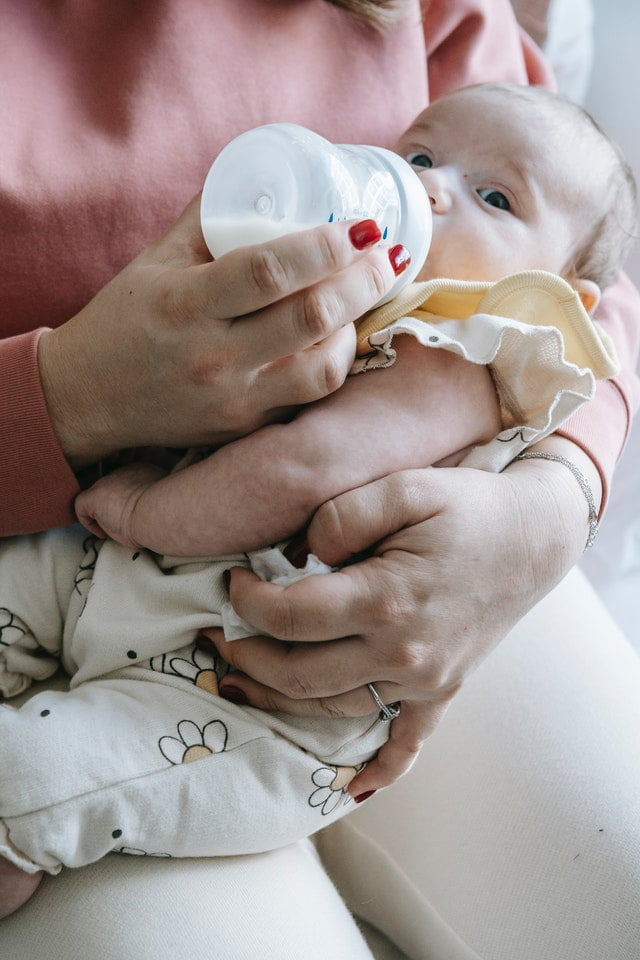SIGNS OF HUNGER BABY AND FULLNESS CUES
- Published on:
- Last update: 13 November 2023

SIGNS OF HUNGER BABY
Did you know that babies from birth have an internal hunger and fullness signal telling them when and how much to eat? Honestly, I think it is incredible how they have this innate skill! I also find it amazing how these signs of hunger baby or inner cues don’t disappear with age. Identifying the baby sign for hungry helps ensure your child develops properly through a regulatory mechanism. It’s making sure they eat enough and not too much.
When their body tells them, “Hey, you’re full, you can stop now” or “I’m not quite satisfied yet, let’s have a bit more,” it is making sure they eat enough, but not too much. How can you, as a parent, understand what these body signals mean? After all, they don’t even talk yet…
Feeding your baby can become less stressful for you and them once you put all your expectations aside, listen to what they are telling you, and look for signs of hunger baby. The method we use for this is called responsive feeding.
RESPONSIVE FEEDING – WHAT IS IT?
Responding to your baby’s cues of hunger or fullness through feeding is the process of responding to their natural needs. It would be best to let the child lead the way in this. Your response is to offer more food or end mealtime as soon as they express hunger or fullness, verbally or non-verbally.
Rather than focusing on how much food is eaten at each meal or how many feedings per day, it concentrates on what the individual says they need instead. Baby and toddlers exhibit the best ability to regulate their hunger because they do not rely on a clock to tell them when they should eat based on social norms, as adults do.
They can teach us some things! One of the best things about responsive feeding is that it considers their varying appetites. Sometimes they eat tons, and sometimes they eat almost nothing! It’s perfectly normal. Make that you feed them healthy and organic baby food.
What prevents undernutrition and overnutrition is listening to them and following their lead. Through the use of this program, babies can learn the concept of mindfulness eating, which involves tuning in to their bodies during a distraction-free mealtime to “listen,” so to speak, to their cues and eating when they’re hungry instead of when they’re told they should. As they grow up, this will help to keep them from developing any unhealthy eating habits.
Eating for emotional reasons or simply because they are bored will help to prevent this. Also, since they don’t feel pressured to eat, mealtimes can be less stressful and tension-free as they enter toddlerhood because of their ability to eat without feeling rushed.

AT WHAT POINT DO FEEDING CUES CHANGE?
When you do baby-led weaning or breastfeeding vs. bottle-feeding, for example, or when you do purees vs. breastfeeding, responding to your baby’s needs will look vastly different. Whenever you have a toddler, things will get even more interesting. The primary focus remains listening to their signs of hunger baby and responding accordingly regardless of how things look in each stage!
HUNGRY BABIES: HUNGER CUE ONCE BABY STARTS SOLIDS:
- As if accepting or looking for food by opening mouth and leaning towards food
- The act of eating the following food with the eyes
- Food makes them excited
- Food reaching out to be grabbed
- Maintaining a consistent pace of eating
HUNGRY BABIES: FULLNESS CUES ONCE BABY STARTS SOLIDS:
- Removes food from a spoon and throws it away
- Whenever you offer food, his mouth closes
- Spits out food
- Baby gets distracted easily. Hungry babies usually eat quickly at the beginning of the meal.
- The child tries to leave a highchair or table
- They may also throw food to indicate they’re done
- Eating at a slower pace
Suppose only one of these cues is present. In that case, you might not be able to tell for certain whether they are hungry or full, but if they’re present in combination with other ones, and once you witness them happening once or twice, you can be confident it’s the right behaviour. With practice and some time, it will become easier. You’ll recognize the signs quickly once you learn what your baby does specifically!

SIGNS OF HUNGER BABY: TODDLERHOOD
Toddlers are the best. The ability to talk, or at least to communicate in some way. A constant request for snacks would be nice, too. It’s hard at this age, but not impossible, to make sure that the child gets responsive to feeding. Because they’re most likely to get distracted at this age, because they’re constantly on the move and babies can be picky eaters, it can be difficult to make sure they’re getting enough food. It becomes incredibly important to trust your toddler that they know their bodies best here!
It is an age when they are more verbal and can express themselves more easily through the use of words such as “I’m full.”. But they don’t always use that phrase (or use it incorrectly), so here are some other cues to watch for that show hunger/fullness:
Therefore, I recommend establishing a regular feeding schedule. By following your role of feeding and deciding what to serve, when to serve it, and where to serve it, you can contribute to honouring responsive feeding. Then let the babies decide how much and how often they want to eat at every feeding opportunity. It is an excellent way for toddlers and older kids to teach mindfulness eating, as it shows them that you’re confident about setting and keeping boundaries.
HOW TO SET YOURSELF UP FOR SUCCESS: HUNGRY BABIES
A few things you can do to make responsive feeding a walk in the park are a few things you can do to help nail down and build the best relationship with your baby.
- You should become more aware of your baby’s communication with you. It may not yet be apparent what they are feeling, but you can watch for their non-verbal cues, like pulling things towards their mouth when they are hungry or pushing things away when they are full. Being fully committed to giving them attention at mealtimes allows you to make sure you are doing your best. As time passes, this will become easier and easier. After some practice, you’ll begin to notice patterns and be more confident about trusting your baby’s signs.
- Keep distractions at a minimum during mealtimes! Nothing can distract you from your baby, including phones, TVs, and iPads. You’ll have more time to bond with them and understand their communication style by giving them all your attention. Any distraction can also cause them to lose sight of whether they are hungry or full, leading to them mindlessly eating or not eating enough.
- Feeding should follow the division of responsibility. Always be mindful of it and build a trusting relationship with your dog. You can feel confident in knowing that by following through on your role and concentrating only on it, your baby/toddler will be more trusting to you. You will gain more trust when you let them focus and own their role in feeding. You will ensure your baby/toddler is as healthy as possible and won’t have any nutritional stress around feeding.
LET THE HUNGRY BABY DECIDE
I believe that you should practice responsive feeding by stopping when your child lets you know they’re full. Give your baby the option of how much food they want to eat. Stop trying to get that last bite in! As your child learns to listen to their body when eating and stop eating when they are full, this is the time to teach them to stop eating. Maintaining a positive feeding experience is important to your baby, as it will help you both anticipate future meals.
Reference: New Mommy
Images: Pexels
Share this post:

